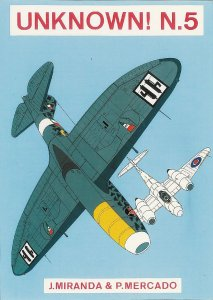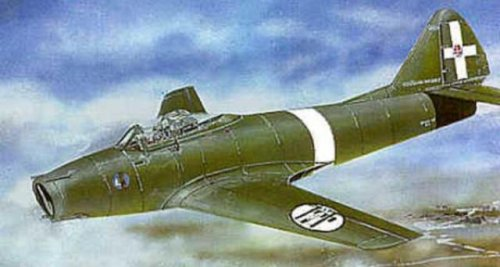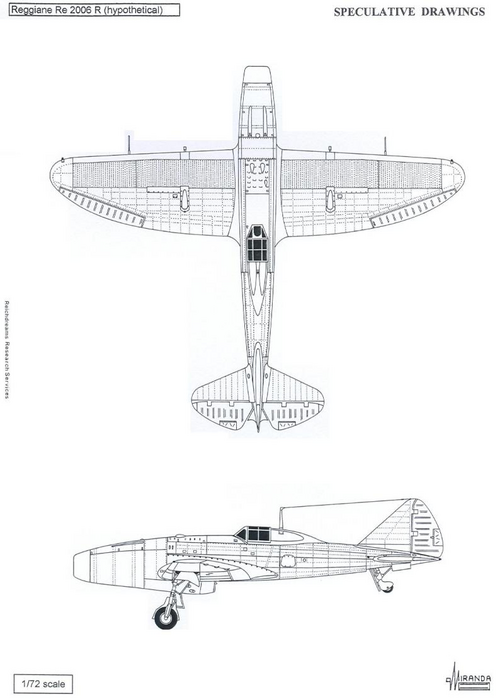Posted January 15, 2008
Hi,
I have a theory that could explain part of the puzzle on the Re 2007.
Skybolt, my apologies for getting into your turf. Please remember that it is just a theory.
Reggiane Re 2006 R, Re 2007 & Re 2008
Doubtless this is one of the most elusive subjects I have ever encountered in our research. In spite of all the existing publications on the Re 2007 issued in the last 58 years (please see attached biography if you feel up to the task) the problem remains unsolved.
There are two schools of thinking on the matter, both defended by serious authors who undeniably act on good faith.
Two points of view
• The “conservative” version says that the Re 2007 never existed. It was just a project of postal airplane with radial engine derived from the Re 2006 and which original designation had been Re 2006 PP.
Logical reasoning if we consider that this is the only type of airplane derived from the Re 2006 that could have been successful in post war Italy.
There is also significant evidence. The chef test pilot at Reggiane, Maggiore Tullio de Prato who, in declarations made in October 1977 denied his knowledge on the existence of a project known as Re 2007.
• The “liberal” version states that a swept wing jet fighter was built in Italy during the war. It never reached flying stage as it was impossible to obtain the Jumo 004B turbojet that Germans have promised to deliver to the Reggiane firm.
The main argument used to defend that option is a letter dated January 7th 1944 in which Ing. Roberto Longhi, former chief-designer of Reggiane, requested the help of Count Doct. Ing. Gianni Caproni. He wished to obtain information on measurements and performances of the Jumo 004 with the objective of initiating the assembly of the Re 2007.
There are two controvert drawings of the Re 2007, a cutaway and a three view, dated January 7th 1944.
The author G. Cometti has been accused of chronological fraud by some experts. Apparently, the paper on which the drawings were made was of the type used by the Reggiane firm in the post war years.
According to certain opinions they might have been made as late as 1960, under the direction of Ing. Longhi.
Known by certain
In 1942 the Regia Aeronautica decided to acquire the production license of the German engine DB 603 of 1750 hp to drive their new fighters of the “6 series”: the Fiat G.56, the Macchi C.206/207 and the Reggiane Re 2006.
The manufacturing of two prototypes of the latest model was ordered on 9 May 1943, being assigned the registration numbers MM 540 and MM 541.
According to official history, German authorities cancelled the two orders on 8 September 1943. However the Reggiane workers decided to secretly continue the construction of the MM 540 in Reggio Emilia, using a standard Re 2005 with an enlarged fuselage to compensate the bigger size and power of the DB 603.
The airplane was shipped to Corregio in January 1944 in separate parts to keep it safe from the Allies bombing while being finished at a gymnasium of the town.
After the war it was moved to the Instituto Politecnico di Taliedo where it was scrapped by the end of 1946, following orders from the Allied authorities.
Discrepancies
As per the “liberal” version the MM 541 was completed in a 70% as a Re 2007. The rear fuselage, wing spars, ribs, undercarriage and cockpit were just finished. Apparently just the engine was missing.
- Considering that the Re 2006 was essentially a Re 2005 with an elongated fuselage, how could it be converted into a swept wing jet fighter with the scarce technical means available at the beginning of 1944?
- There are different versions on the origin of the Jumo 004 that existed in Italy. Some believe that they were spares for the Arado Ar 234 recce planes of the Kommando Sommer based in Campoformido and Udine since February 1944. Others think that the engines intended to be sent to Reggio Emilia came from Germany and were stolen en route by German defectors trying to sell them at 2 millions lire.
Whatever the truth one of these engines survived the war and can be found today at the Vigna di Valle Italian Air Force Museum.
- It seems odd that no original documentation has survived. Such a complex project requires multitude of calculations, scale drawings, wind tunnel models and aerodynamic testing of which no evidence could be found.
- Finally there is the engine represented in the Cometti drawings. Evidently it was not a Jumo 004. With its length of 3.86 m could have never be installed behind the wing spar in such a small airplane without perilously altering its center of mass.
Our best estimation is that it is a Metropolitan-Vickers F-2 manufactured in Great Britain in 1942.
Although the engine was technically superior to its Power Jets counterparts, it was estimated that its excessive complexity would make mass production difficult and the project was cancelled in 1944.
If the engine would have been British, would have the Italians acquired the manufacturing licence of the Metrovick during the immediate post war? Were the Cometti drawings part of an Anglo-Italian project that did not turn out well?
A possible solution
Apparently the problems would considerably simplify if every group of opinion were talking of two different airplanes which each one tend to identify with the mythical Re 2007.
On one side we have the MM541 that, if finally built, would have been a standard Re 2005 slightly modified to fit it with a turbojet, but……how?
There are several contemporary examples of fighters originally designed with a conventional piston engine that were modified by adding a bent down turbojet to its nose, so that the gases expelled by the nozzle would not damage the structure of the fuselage.
In 1945 the Soviets transformed an all-metal second generation Yak-3 airframe installing a Jumo 004 B in the nose. The new airplane, named Yak-15, was mass manufactured entering into service without any problems. The success of the formula was such that a second model was built, specifically designed with the nose engine and under the name Yak-17.
Another Soviet manufacturer, Lavockin, also used the same system in his designs La-152, La-154, La-156 and La-174 Tk.
In Italy, the designer Sergio Stefanutti, who in 1946 have had access to the Jumo 004 engines to study them, used the same solution than the Soviets but transforming the SAI Ambrosini S.7 “Freccia” in the “Sagittario I”. He achieved that by replacing its Alfa Romeo 115 ter piston engine by a Turboméca Marboré II jet engine installed in the nose with 3º 30' rotation tilting, compared to the longitudinal axis of the aircraft.
Tests of the "Sagittario I" performed in December 1952 were successful, except by some heating problems in the lower section of the fuselage during the ground wheeling. They were partially resolved modifying the tail wheel (the Soviets also replaced it by a metallic one in the Yak-15) and recommending the adoption of tricycle undercarriage in future designs.
In 1953 it was decided the construction of 45º swept jet fighter, based on the same formula. The new airplane, named "Sagittario II", flew for the first time in May 1956, powered by a R.R. Derwent 9 turbojet installed in the nose with a 20º slope.
The “Sagittario II” was the first Italian airplane in overcoming Mach 1 during a flight made on 4 December 1953.
From these examples could be concluded that the Reggiane technicians planned to install the Jumo 004 in the MM 541 using the same system. Would that have been the case, the MM 541 might have looked similar to that shown in the attached drawing, where the tail wheel and anti-torque angled tailfin have been modified.
In our opinion its correct denomination should be Re 2006 R (Reazione) to be consistent with another jet project by the same firm, the Re 2005 R, powered by a Caproni thermojet (please see UNKNOWN! No 2)
Following this hypothesis the derived versions from the Re 2006 would be:
- Re 2006 C “Corsa” (Racing) designed to compete in the USA Bendix Trophy with a DB 603 engine.
- Re 2006 P “Postale” (Postal) designed to transport mail with a 1500 hp Pratt & Whitney radial engine
- Re 2006 PP “Postale- Passegeri” (Postal-Passengers) designed to transport either mail or six passengers with a 1500 hp Pratt & Whitney radial engine
- Re 2006 R “Reazione” (Jet propulsion) designed as jet fighter with a Jumo 004 B turbojet
Regarding the swept wing design, it seems to be inspired in the American and Soviet jet fighters of the last 40s.
If the Cometti drawings were made under the supervision of Longhi, why are they not including a Jumo engine to be consistent with the alleged design date of 1944?
It is obvious for us that this airplane was designed for an engine smaller than the Jumo, which would not be available for the Italians until much later than 1944.
Our opinion is that the design originated at 1949-1950 and, due to some obscure legal marketing issue, it was necessary to redraw it with a very earlier date on it.
The reason might be named Re 2008. This project of swept wing fighter was designed by Longhi in USA between 1947 and 1948 with the technical support of Cornell Aeronautical Laboratory, which counted with a high speed wind tunnel, impossible to find in Italy at that time.
Apparently Longhi tried to manufacture the Re 2008 in Europe when the Reggiane firm took up its activities again, something which did not happen due to political reasons.
The fact is that Americans did not like this covered transfer of technology. Actually, they suspected that the Re 2000 designed by Longhi was a copy of their Seversky P.35 fighter.
The Re 2008 also looked very much alike the F-86 Sabre and, given that such wing type could not have been designed in Italy for lack of technical means, there was a legal problem of copyright as Americans considered German swept wing technology as prize of war.
It is perhaps for that reason that a phantom project named Re 2007 was “created in 1944”, possibly alleging that the swept wing was a wartime Germany originated technology transfer.
The Re 2008 (Caproni-Reggiane Ca.2008 according to other authors) was a swept wing jet fighter propelled by an axial-flow turbojet of an unspecified type with 5000 lb of thrust.
The wing had 36º swept in the leading edge and -5º dihedral angle. It had four slots in the leading edge and mid-wing transonic fences. The airfoil was a high speed NACA 66.
The fuselage had airbrakes and could be divided in three sections to facilitate the change of engine.
The cockpit, of an archaic design, was pressurized.
The armament was to be four Mauser MG 151 guns of 20 mm, located around the air-intake duct.
It could also transport 12 HVAR rockets under the wings.
Estimated technical data for the swept wing Re 2007 (Re 2008 between brackets)
Span 9.5 m (9 m)
Length 9 m (12 m)
Height 3 m (2.75 m)
Wing area 17 m2 (16 m2)
Empty weight 2500 kg (2400 kg)
Loaded weight 3540 kg (3900 kg)
Max speed Mach 0.85 (Mach 0.95)
Service ceiling 15000 m (20000 m)
Bibliography
• “L’Ala” No. 2, 3 and 4. 1948
• “Dal Re 2002 al Re 2005”, by Sergio Govi, Giorgio Apostolo Ed 1984
• “I Reggiane dall’A alla Z”, by Sergio Govi, Giorgio Apostolo Ed 1985
• “I Caccia Caproni Reggiane 1938-1945” Intyrama 1968
• “Gente dell’Aria No. 4” by Giorgio Evangelisti, Editorialle Olimpia 1997
• “Reggiane Re 2005” by Gregory Alegy, Bancarella A. 1991
• “Reggiane Re 2006, una Storia vera” IBN Editore 2002 by Alessandro Berteletti
• “Dal SAI Ambrosini Sagittario all’Aerfer Leone” by Giuseppe Ciampaglia. IBN Editore 2004
• “Royal Air Force Flying review”, October 1957
• “Mecanica Popular”, March 1958
• “Air Enthusiast”, July 1971
• “Aircraft Profile Publications” No. 244 by John F. Brindley, November 1972
• “The Caproni Reggiane Fighters 1938-1945” by Piero Prato 1971
• “Reggiane Re 2005” by Claudio Tatangelo, Monografie aeronautiche Italiane 1990
• “Reggiane Re 2005 Sagittario” by Mauricio Terlizi, IBN Editore 1999
• “Reggiane 2005 Sagittario” by Nino Arena, Mucchi editore
• “Ali Antiche” No. 54, September 1999
• “Air Enthusiast Quarterly” No. 2, 1976
• “Flying review” May 1966
• “Aerofan” No. 68, January 1998
• “Air war Italy 1944-45” by Nick Beale, Airlife 1996
• “Ritratto segreto dell’Aeronautica italiana nella Seconda Guerra Mondiale”, by Giuliano Colliva, Storia Militare No. 63, 1998
• "Vita ignorata del Centro Studi ed Eperienze di Guidonia” by Bruno Lattanzi
• “Re 2007” by Daniele Lembo, Storia e Battaglie No.4, Ed. Lupo 2000
• “Storia Militare” No. 59, August 1998
• “Regia Aeronautica. Registro delle Matricole Militare e delle Commesse”. AMI Archives, Rome.
• “Alas italianas en la Segunda Guerra Mundial (XXXIV)” by S. Rello, “Flaps”.
• “Les Ailes” No. 1463, 13/02/54
• “JP4” magazine No. 11, 1976
•
http://pub157.ezboard.com/fluftwaff...MessageRange?topicID=26.topic&start=1&stop=20
•
http://www.secretprojects.co.uk/forum/index.php?action=printpage;topic=835.0
•
http://www.secretprojects.co.uk/forum/index.php?action=dlattach;topic=835.0;atach=7352
•
http://cloud.prohosting.com/hud607/uncommon/aircraft/re2005/re2007.html
•
http://www.aerei-italiani.net/SchedeT/aereore2007.html
•
http://www.geocities.com/CapeCanaveral/Launchpad/2569/RE2007.html
•
www.luftwaffe-experten.org/forums/index.php
•
http://m2reviews.cnsi.net/reviews/axis/ity/wanta2007.htm
•
http://cloud.prohosting.com/hud607/uncommon/aircraft/re2005/re2007.html
•
http://it.wikipedia.org/wiki/Reggiane-progetti_avanzati





























